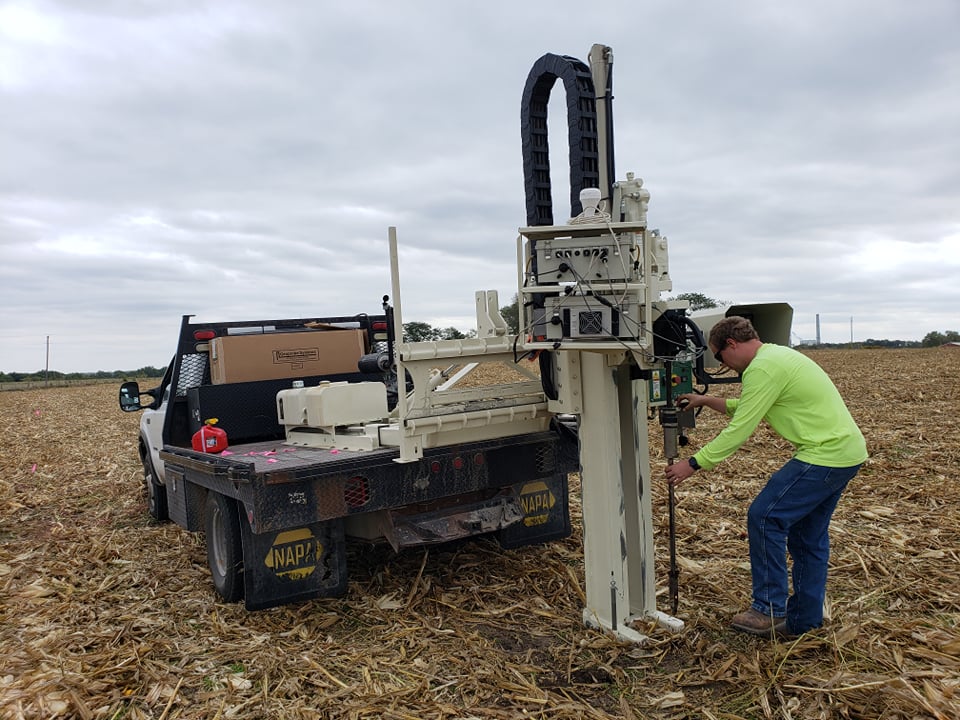Published on
Updated on
CAFNR, USDA-ARS collaboration helps farmers adopt digital technologies to improve their operations
Written by Logan Jackson

This story appears in our MU CAFNR/Agricultural Experiment Station Research Magazine.
The United States Department of Agriculture (USDA) Agricultural Research Service (ARS) has a long and productive history of research collaborations that have resulted in important long-term data for farmers and producers across Missouri.
CAFNR serves as a regular collaborator with USDA-ARS, including numerous current projects within the Cropping Systems and Water Quality Research Unit. One of those projects is focused on improving upon traditional soil carbon modeling approaches by incorporating measurements from multiple soil sensors. Part of the funding for the project is coming from the USDA-ARS Artificial Intelligence (AI) Center of Excellence.
The project team includes two ARS soil scientists, Kristen Veum and Newell Kitchen, and an ARS engineer, Ken Sudduth. All three are adjunct faculty within CAFNR, and they are teaming up with Jianfeng Zhou, an assistant professor in the Division of Plant Science and Technology.
“Whether we’re ARS scientists or University of Missouri faculty, our projects and their importance really depend on our research being adopted,” Sudduth said. “We put a lot of emphasis on helping farmers with their decision making, which, in this case, includes helping them bridge the gap between our sensor data and what they can do with that data to improve their operations.”
Sudduth said the main idea behind this specific project is to research how different sensing technologies can come together to help farmers understand how soil health and soil properties relate to crop production. They are collecting soil samples and soil carbon measurements, along with soil sensor data, which includes near-infrared reflectance, apparent electrical conductivity and penetration resistance.
“Using the data collected, we are developing a convolutional neural network (CNN) model to estimate soil carbon and bulk density,” Sudduth said. “We’re training the CNN model on a random subset of the reflectance data and testing it on the remaining data using a high performance computer. A more traditional model is being used as a baseline for performance.”
Zhou’s role in the project centers on his expertise in AI-based data analysis and modeling. He and his graduate students are helping with data collection and are developing prediction models for soil carbon content using CNN models. Zhou said he hopes to discover more insights into the complex data from the advanced sensors and instruments, using state-of-the-art data analysis and modeling techniques.
“This is the great part of working with our collaborators in CAFNR,” Sudduth added. “They bring expertise that we may not possess – and Jianfeng is an awesome example of that. His UAV data brings new avenues to help us understand our sensing system even better. There are many new opportunities that the UAV data could bring us.”
Sudduth has been using sensor data in his research for many years. He said that in recent years he has seen farmers and producers adopt this data to help improve their operations.
“Farmers are getting more and more comfortable with digital data,” Sudduth said. “They are starting to understand the best ways to utilize that data. At the end of the day, they want their operations to be more efficient. We want to help them get the best value for the technology that they have.”
Sudduth added that he, Kitchen and Zhou are working on a few different projects together. Those projects are spread throughout mid-Missouri, including locations at the Central Missouri Research, Extension and Education Center (CM-REEC). Farms like Sanborn Field offer similar long-term data plots that mimic ARS’ long-term research goals.
“Our mission in ARS is to help make farmers and producers more profitable and help them problem solve,” Sudduth said. “We’re fortunate to have great long-term sites where we can provide a solid foundation of data and work with our CAFNR colleagues to provide answers to multiple questions. Sanborn Field has been a vital site for years, and will continue to be useful as we study different cropping systems.”
Long-term data collection is important for researchers because conditions can vary from year-to-year. Climate conditions, for example, can be stable over a three-year period. However, if data is collected over a 20- to 30-year period, it can capture how crops fare through droughts and floods.
“Being able to see long-term datasets is vital,” Sudduth said. “It allows us to look at the entire suite of growing conditions. Another positive is that prolonged research shows us the progression of technology, from seed genetics to equipment. Having that baseline gives us the opportunity to evaluate multiple things over the years.”
Sudduth received his bachelor’s and master’s degrees in agricultural engineering from Mizzou. He was actually a student employee in the same Cropping Systems and Water Quality Research Unit where he works now.
“The technology has changed over the years, but we’ve always been doing innovative research,” Sudduth said. “It’s been really rewarding to see farmers and producers get involved in the entire process. When I first started this type of work, we would maybe get a little bit of land and farmers would just kind of let us go about our work. They’re so engaged now. Our work is very participatory and farmers are really tapping into the data we are providing.”